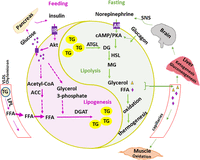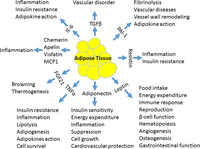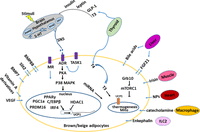Adipose tissue in control of metabolism
- 1Department of Metabolism and Endocrinology, Metabolic Syndrome Research Center, Key Laboratory of Diabetes Immunology, National Clinical Research Center for Metabolic
Diseases, The Second Xiangya Hospital,
Central South University, Changsha, Hunan, China - 2Department of Biochemistry and Molecular Biology, University of New Mexico Health Sciences Center,
Albuquerque, New Mexico, USA
- Correspondence should be addressed to M Liu; Email: meilianliu{at}salud.unm.edu
-
Figure 1
Lipid metabolism and mobilization controlled by adipose tissue. Lipogenesis is a process by which carbohydrate is converted into fatty acids, and promotes the biosynthesis of TG and expansion of lipid droplet in adipocytes. Lipolysis, in an opposite way, breaks down TG to free fatty acid (FFA) and glycerol that can be either oxidized or released. The uptake of circulating FFA by liver, muscle and other tissues is a main pathway of lipid mobilization. Both lipogenic and lipolytic pathways are sensitive to nutrition as well as hormones such as insulin, norepinephrine and glucagon. Thus, a subtle regulation of lipogenesis and lipolysis is required for systemic energy homeostasis and insulin sensitivity. AR, adrenergic receptor; cAMP, cyclic adenosine monophosphate; IR, insulin receptor; PKA, protein kinase A.
-
Figure 2
The physiological functions of adipokines. Adipokines, the cytokines derived from adipose tissue, act to regulate insulin sensitivity, inflammation, cardiovascular function, behaviour and cell growth, resulting in the development of obesity-induced metabolic diseases. ASP, acylating simulation protein; FGF21, fibroblast growth factor 21; IL6, interleukin 6; MCP1, monocyte chemoattractant protein 1; PAI1, plasminogen activator inhibitor 1; TNFα, tumour necrosis factor alpha.
-
Figure 3
The regulation of adaptive thermogenesis. Thermogenic programme and browning of WAT are driven by SNS in response to cold, diet and stress. Several hormones such as insulin, leptin, BMP8B, GLP-1 and T3 control adaptive thermogenesis through regulating SNS. Moreover, several key transcription factors such as PRDM16, PGC1α, PPARγ, C/EBPβ and IRF4 assemble to form the transitional machinery of UCP1 and promote UCP1 expression. In addition, adaptive thermogenesis has been shown to be regulated by multiple secreted factors including BMP8B, Slit2, BMP7, vitamin A derivatives, VEGF, T3, bile acids, FGF21, irisin, NPs, enkephalin and macrophages-derived catecholamine. In addition, HDAC1 and miRNAs as well as other intracellular pathways such as p38MAPK, mTORC1, Grb10, MR and TASK1 play important roles in regulating thermogenic program. Double arrow means secretion from adipocytes and in turn action on itself. ADR, adrenergic receptor; MR, mineralocorticoid receptor; NPs, natriuretic peptides; TASK1, Twik-related acid-sensitive K (+) channel; 5-HT, 5-hydroxytryptamine or serotonin neurons.
- © 2016 Society for Endocrinology














